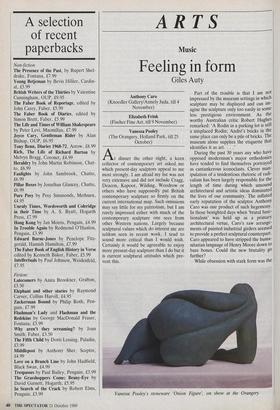ARTS
Music
Feeling in form
Giles Auty
Anthony Caro (Knoedler Gallery/Annely Juda, till 4 November) Elizabeth Frink (Fischer Fine Art, till 9 November) Vanessa Pooley
(The Orangery, Holland Park, till 25 October) At dinner the other night, a keen collector of contemporary art asked, me which present-day sculptors appeal to me most strongly. I am afraid my list was not very extensive and did not include Cragg, Deacon, Kapoor, Wilding, Woodrow or others who have supposedly put British contemporary sculpture so firmly on the current international map. Such omissions may say little for my patriotism, but I am rarely impressed either with much of the contemporary sculpture one sees from other Western nations. Largely because sculptural values which do interest me are seldom seen in recent work, I tend to sound more critical than I would wish. Certainly it would be agreeable to enjoy more present-day sculpture than I do but it is current sculptural attitudes which pre- vent this. Part of the trouble is that I am not impressed by the museum settings in which sculpture may be displayed and can im- agine the sculpture only too easily in some less prestigious environment. As the worthy Australian critic Robert Hughes remarked: 'A Rodin in a parking lot is still a misplaced Rodin; Andre's bricks in the same place can only be a pile of bricks. The museum alone supplies the etiquette that identifies it as art. . .
During the past 30 years any who have opposed modernism's major orthodoxies have tended to find themselves portrayed as cantankerous iconoclasts. Clever man- ipulation of a tendentious rhetoric of radi- calism has been largely responsible for the length of time during which unsound architectural and artistic ideas dominated the lives of our community. The inflated early reputation of the sculptor Anthony Caro was one product of such hegemony. In those benighted days when 'brutal func- tionalism' was held up as a primary architectural virtue, Caro's raw arrange- ments of painted industrial girders seemed to provide a perfect sculptural counterpart. Caro appeared to have stripped the huma- nitarian language of Henry Moore down to bare bones. Could the new brutality go further?
While obsession with stark form was the Vanessa Pooley's stoneware 'Onion Figure', on show at the Orangery fashion, it was easy to overlook the lyrical or even whimsical qualities present in Caro's work. Indeed, it is these which emerge so strongly now — if in new guises — in the double exhibition of his more recent pieces at Knoedler (12 Cork Street, WI) and Annely Juda (11 Tottenham Mews, WI). Caro can do lyrical things with what seems, on the face of it, extraordi- narily prosaic materials. The early stark- ness has gone now in favour of greater formal complication. Today Caro even seeks sculptural equivalents in heavy metal for great masterpieces of painting such as Rembrandt's 'Descent from the Cross' and Manet's `Dejeuner sur l'Herbe'. Yet I believe Caro's work is at its best when most witty and instinctive — as in his Catalan Pieces — rather than when it harks back to problems which are largely formal.
Although six years younger than Caro, Elizabeth Frink is basically of the same sculptural generation, yet has managed to pursue an idiosyncratic course which has been little influenced by the supposed temporal imperatives followed faithfully by Others. Frink's attitudes are laudable and I wish I could feel comparable admiration for her recent sculpture at Fischer Fine Art (30 King Street, SW1). The show centres round a series of seven foot high male figures whose apparent inspiration was the so-called `Riace Warriors', recently disco- vered Greek sculptures from the fifth century. However, I find these figures more redolent of Greek Street, Soho, than any ancient culture — heavy-legged and slightly arthritic night-club bouncers, perhaps, rather than warrior archetypes. Their build looks more suitable for turning People over than turning them on, but I gather they have their feminine admirers. I claim no competence to judge male magnetism but feel the line between the rawly primitive and the grotesque is a fine ?ne. In the meantime I found Frink's intentionally simian figures, which are to be found downstairs at Fischer's, more naturally sympathetic.
During the past week I have managed to be present also at an open day at the Battersea studio of two young sculptresses, Maria Greenshields and Maria Marshall, whose own petite pre-Raphaelite forms belie surprising abilities to arrange and weld heavy scrap metal, often to brilliant and humorous effect. I also attended an exhibition of unusual small figures by Vanessa Pooley at the Orangery, in the middle of Holland Park, W8. Miss Pooley's intriguing work could be seen as an amus- ing assault on men's fashion-led longings for slender and pliant womanhood. Her finely made female figures have a low- slung earthiness and moving vulnerability that speak of earlier and perhaps truer concepts of her gender: woman as vessel rather than vassal perhaps. Miss Pooley plays with organic forms to strange and telling effect. Her show has a week to run; try not to miss it.



























































 Previous page
Previous page